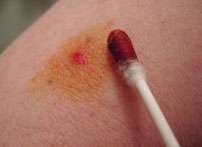Iodine (medical use)
Iodine is used to treat and prevent iodine deficiency and as an antiseptic.[1][2] For iodine deficiency it can be given by mouth or injection into a muscle.[1] As an antiseptic it may be used on wounds that are wet or to disinfect the skin before surgery.[2]
 | |
| Clinical data | |
|---|---|
| Trade names | Iodoflex, Iodosorb, others |
| AHFS/Drugs.com | Monograph |
| License data | |
| Pregnancy category |
|
| Routes of administration | topical, by mouth, IM |
| ATC code | |
| Identifiers | |
| CAS Number | |
Common side effects when applied to the skin include irritation and discoloration.[2] When taken by mouth or injection side effects may include allergic reactions, goitre, and thyroid dysfunction.[1] Use during pregnancy is recommended in regions where deficiency is common, otherwise it is not recommended.[1][2] Iodine is an essential trace element.[1]
In 1811, Bernard Courtois isolated iodine from seaweed while in 1820 Jean-Francois Coindet linked iodine intake to goiter size.[3] It initially came into use as a disinfectant and for goiter.[4][5] It is on the World Health Organization's List of Essential Medicines, the safest and most effective medicines needed in a health system.[6] Table salt with iodine, known as iodized salt, is available in more than 110 countries.[7] In areas with low dietary iodine one dose of iodine a year at 0.32 USD per dose may be recommended.[8][1]
Society and culture
So wide spread was the importance of iodine in the society that, it has mention in policy making, which is indirectly related to public health.
Formulations
A number of iodine containing formulations are also used medically including:[9]
- potassium iodide (supplement)
- Lugol’s solution (supplement and disinfectant)
- povidone-iodine (disinfectant)
- iohexol (contrast agent)
- amidotrizoate (contrast agent)
- meglumine iotroxate (contrast agent)
- radioactive iodine
- Tincture of iodine
- So-called nascent iodine
- Iopanoic acid (contrast agent)
- Amiodarone (30% iodine content)
References
- WHO Model Formulary 2008 (PDF). World Health Organization. 2009. p. 499. ISBN 9789241547659. Archived (PDF) from the original on 13 December 2016. Retrieved 8 January 2017.
- "Iodine". The American Society of Health-System Pharmacists. Archived from the original on 13 January 2017. Retrieved 8 January 2017.
- Leung, AM; Braverman, LE; Pearce, EN (13 November 2012). "History of U.S. iodine fortification and supplementation". Nutrients. 4 (11): 1740–6. doi:10.3390/nu4111740. PMC 3509517. PMID 23201844.
- Preedy, Victor R.; Burrow, Gerard N.; Watson, Ronald Ross (2009). Comprehensive Handbook of Iodine: Nutritional, Biochemical, Pathological and Therapeutic Aspects. Academic Press. p. 135. ISBN 9780080920863. Archived from the original on 12 August 2017.
- Sneader, Walter (2005). Drug Discovery: A History. John Wiley & Sons. ISBN 9780471899792. Archived from the original on 13 January 2017.
- World Health Organization (2019). "World Health Organization model list of essential medicines: 21st list 2019". World Health Organization (WHO). hdl:10665/325771. Cite journal requires
|journal=(help) - Watson, Ronald Ross; Gerald, Joe K.; Preedy, Victor R. (2010). Nutrients, Dietary Supplements, and Nutriceuticals: Cost Analysis Versus Clinical Benefits. Springer Science & Business Media. p. 37. ISBN 9781607613084. Archived from the original on 13 January 2017.
- Rosso, Joy Miller Del; Marek, Tonia (1996). Class Action: Improving School Performance in the Developing World Through Better Health and Nutrition. World Bank Publications. p. 21. ISBN 9780821336724. Archived from the original on 13 January 2017.
- The selection and use of essential medicines: Twentieth report of the WHO Expert Committee 2015 (including 19th WHO Model List of Essential Medicines and 5th WHO Model List of Essential Medicines for Children) (PDF). WHO. 2015. pp. many. ISBN 9789240694941. Archived (PDF) from the original on 20 December 2016. Retrieved 8 December 2016.
External links
- "Iodine". Drug Information Portal. U.S. National Library of Medicine.